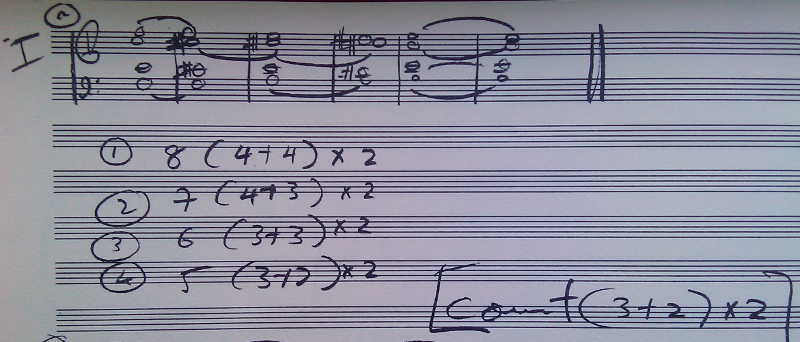I saw the Robert Wilson/Philip Glass opera Einstein on the Beach about a month ago and wrote about it here. It was astounding. I've kept on listening to it and done some reading about it, and here's something I found about a very small part of the music, about thirty seconds, that intrigued me.
Open up this audio clip in another window and play it a couple of times. It's the first fragment of "Knee Play 3." The knee plays are short pieces that comes between the acts.
Audio clip of the first fragment of "Knee Play 3" from Einstein on the Beach
It's a lot of numbers, eh? Over and over, changing slightly. Just hearing it on its own I found it hard to understand, and I got curious about how Glass had scored it. What did the singers have in front of them?
Well, I still don't know what the full score looks like, but here's what it originally looked like, written in Philip Glass's own hand, taken from Einstein on the Beach, a limited edition book from 1976 edited by Vicky Alliata:

It's an algorithm. It's code.
Here's what's going on, as I understand it. The score written down sets out six bars of music, and the whole notes used there indicate the pitches used to sing the music but without getting into finicky details. The double line at the end means the whole thing is repeated.
"8 (4 + 4) x 2" means count eight, four plus four, one-two-three-four one-two-three-our, for each bar in the score (that is, six times), and repeat it (x 2).
Fully expanded, Glass's formula becomes:
(1) 8 (4 + 4) x 2
12341234 12341234 12341234 12341234 12341234 12341234
12341234 12341234 12341234 12341234 12341234 12341234
(2) 7 (4 + 3) x 2
1234123 1234123 1234123 1234123 1234123 1234123
1234123 1234123 1234123 1234123 1234123 1234123
(3) 6 (3 + 3) x 2
123123 123123 123123 123123 123123 123123
123123 123123 123123 123123 123123 123123
(4) 5 (3 + 2) x 2
12312 12312 12312 12312 12312 12312
12312 12312 12312 12312 12312 12312
I don't know what to make of "count (3 + 2 x 2)," though. If you know what that means I'd like to hear.
See also: Music by Philip Glass, by Philip Glass with Robert T. Jones, which covers Einstein on the Beach, Satyagraha and Akhnaten.
Thanks to Rob van der Bliek and Tim Knight for helping me understand this. Glass uses solfège---where the singer sings the name of a note when singing that note---elsewhere in the opera, and Tim said the counting here reminded him, on similar lines, of the Indian method of solkattu, for speaking rhythms (Glass studied Indian classical music in the 1960s).
 Miskatonic University Press
Miskatonic University Press